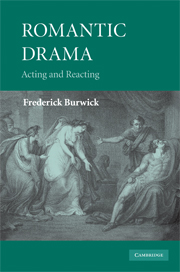Book contents
- Frontmatter
- Contents
- List of illustrations
- Acknowledgments
- Introduction
- 1 Periscopes into the theatre
- 2 Nationalism and national character
- 3 Genre: the realism of fantasy, the fantasy of realism
- 4 Acting: histrionics, and dissimulation
- 5 Transvestites, lovers, monsters: character and sexuality
- 6 Setting: where and elsewhere
- 7 Gothic and anti-Gothic: comedy and horror
- 8 Blue-Beard's castle: mischief and misogyny
- 9 Vampires in kilts
- Notes
- Bibliography
- Index
6 - Setting: where and elsewhere
Published online by Cambridge University Press: 04 August 2010
- Frontmatter
- Contents
- List of illustrations
- Acknowledgments
- Introduction
- 1 Periscopes into the theatre
- 2 Nationalism and national character
- 3 Genre: the realism of fantasy, the fantasy of realism
- 4 Acting: histrionics, and dissimulation
- 5 Transvestites, lovers, monsters: character and sexuality
- 6 Setting: where and elsewhere
- 7 Gothic and anti-Gothic: comedy and horror
- 8 Blue-Beard's castle: mischief and misogyny
- 9 Vampires in kilts
- Notes
- Bibliography
- Index
Summary
The most popular and familiar of border crossings in the Romantic period were marked by the proscenium arch. Theatre was at once an international venue and a showcase for national prejudice toward other countries, other customs. While much is revealed in the dramatic setting and the stage representation of foreign character and intrigue in plays by British writers, even more telling were their translations and adaptations from the drama of other countries. Robert Young, in White Mythologies (1990) argued that “the creation of the Orient … signifies the West's own dislocation from itself, something inside that is presented, narrativized, as being outside.” While “arm-chair travelers” encountered vicariously the foreign and strange in their reading of travel narratives, the drama of the period enhanced such encounters through the vivid impact of theatrical setting and action, yet often replicating the images familiar as book illustrations. The inside–outside disjunctures of heterotopia nourished, and were nourished by, the growing consciousness of Empire in the Romantic period.
The setting of a play (where the action is supposed to take place) determines as well the stage sets (how that setting is visually represented on stage). Whatever is on stage is “other.” The era of picture-book stage designs in Britain commenced in 1767 when David Garrick hired Philippe-Jacques de Loutherbourg to create his illusionist renderings of nature and architecture. De Loutherbourg's set designs also used oil lamps to simulate moonlight and nocturnal street scenes.
- Type
- Chapter
- Information
- Romantic DramaActing and Reacting, pp. 151 - 169Publisher: Cambridge University PressPrint publication year: 2009



